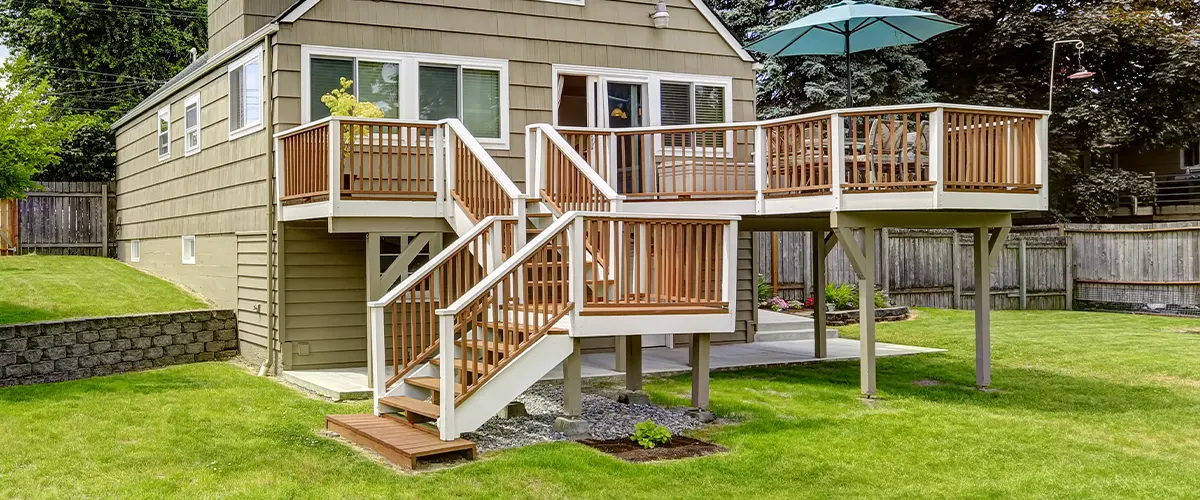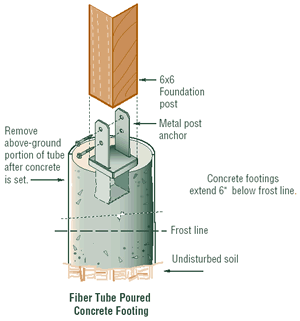Building a Strong Structure: Revealing the Secrets of Deck Footing
A strong and well-designed deck footing is necessary for the security and durability of any type of deck structure. In this interesting overview, entitled "Structure a Solid Structure: Introducing the Keys of Deck Ground," we will discover the significance of correct footings, the various types offered, and the elements to consider when picking the appropriate ones for your deck task. We will certainly review the importance of regular maintenance and examination to make certain the ongoing safety and longevity of your deck footings.
Importance of Proper Grounds

One of the main reasons that correct footings are important is to avoid the deck from sinking or moving. Footings that are not deep sufficient or are poorly constructed can trigger the deck to resolve unevenly or shift gradually. This can cause an uneven deck surface, causing a stumbling danger and endangering the structural integrity of the whole deck.

Furthermore, appropriate grounds additionally help to secure the deck from moisture damage. By raising the deck framework above the ground, grounds prevent the wood from entering into straight contact with wetness, decreasing the threat of rot and decay.
Kinds Of Deck Footings
The choice of ideal deck footings is a critical aspect in making sure the stability and durability of a deck framework. There are a number of sorts of deck grounds that can be used, each with its very own benefits and factors to consider.
One typical kind of deck footing is the concrete pier ground. This entails digging openings in the ground and pouring concrete to develop a solid structure for the deck. Concrete piers are functional and can be utilized in a selection of dirt conditions, making them a preferred option for lots of deck tasks.
An additional alternative is the helical pier ground. This kind of footing contains a steel shaft with helical plates that are screwed into the ground. Helical piers are suitable for areas with inadequate dirt conditions or locations susceptible to high water tables. They give excellent security and can be adapted to the preferred height.
For decks developed on shallow or level foundations, a superficial footing may be appropriate. Shallow grounds are generally made from concrete and are put directly on the ground surface. They are best matched for smaller sized decks or areas with stable dirt problems.
Elements to Consider When Choosing Footings
When choosing grounds for a deck, it is vital to carefully take into consideration a number of elements that will ultimately identify the stability and sturdiness of the structure. The initial variable to take into consideration is the kind of dirt on which the deck will be constructed. Various soil types have differing load-bearing abilities, so it is important to evaluate the dirt's capability to support the weight of the deck. In addition, the environment of the region need to likewise be thought about. Extreme weather, such as freezing temperatures or hefty rains, can impact the ground and possibly trigger activity or shifting of the grounds. An additional critical factor is the size and height of the deck. Larger decks with heavy loads or multiple levels call for more substantial grounds to give ample assistance. Furthermore, the products utilized for the grounds must be chosen intelligently. Usual alternatives include concrete, helical piles, and sonotubes. Each product has its negative aspects and advantages, so it is crucial to take into consideration factors such as cost, simplicity of installment, and upkeep requirements. Last but not least, seeking advice from a professional designer or professional can provide this website beneficial insights and make certain that the picked footings meet local building ordinance and guidelines. By very carefully thinking about these aspects, house owners can make enlightened choices when picking grounds for their deck, guaranteeing a resilient and stable structure.
Actions to Prepare and Set Up Footings
To prepare and mount grounds for a deck, it is critical to adhere to an organized approach that ensures stability and toughness. The initial action is to determine the size and number of grounds needed based on the deck layout and local structure codes. By adhering to these steps meticulously, one can make certain that the grounds are appropriately prepared and mounted, supplying a solid structure for the deck framework.
Maintenance and Inspection of Deck Footings
To guarantee the long-lasting stability and safety and security of your deck, normal maintenance and extensive inspections of the deck grounds are crucial. The deck grounds work as the foundation of your deck, supporting the weight and load of the entire structure. In time, these grounds can experience damage as a result of various variables such as weather problems, soil activity, and the natural aging procedure. It is crucial to perform regular upkeep to determine any type of prospective issues and resolve them promptly.
Normal upkeep ought to include web aesthetic assessments of the grounds, looking for signs of damages or deterioration. These can consist of fractures, sinking or changing of the footings, or signs of water damage. Additionally, it is necessary to examine the security of the grounds by using stress or conducting load examinations if essential.
Along with aesthetic assessments, it is suggested to set up specialist inspections every few years. Professionals can analyze the structural integrity of the grounds site link much more properly and supply expert advice on any required repairs or substitutes.
Furthermore, appropriate maintenance also involves taking safety nets to protect the grounds (Deck Footings). This can consist of using water-proof coatings to stop water damage, guaranteeing correct drainage to prevent excessive wetness, and regular cleansing to eliminate debris and protect against accumulation
Conclusion
In final thought, appropriate deck footings play a critical function in making sure the stability and long life of a deck. By comprehending the different kinds of grounds offered and thinking about elements such as soil conditions and neighborhood structure codes, property owners can make enlightened choices when selecting footings for their deck. Additionally, normal maintenance and evaluation of deck grounds is essential to determine any type of possible issues and make sure the safety and security of the structure.
In this useful guide, entitled "Building a Strong Structure: Introducing the Tricks of Deck Footing," we will certainly check out the relevance of correct grounds, the various kinds readily available, and the variables to consider when selecting the best ones for your deck task.One usual kind of deck footing is the concrete pier ground.To ensure the long-lasting security and security of your deck, regular upkeep and detailed evaluations of the deck footings are crucial.In conclusion, appropriate deck grounds play an important duty in ensuring the stability and durability of a deck. By understanding the different kinds of footings readily available and taking into consideration elements such as soil problems and local building codes, property owners can make educated decisions when selecting footings for their deck.